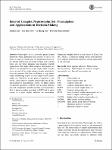




Neutrosophic set is a powerful general formal framework which generalizes the concepts of classic set, fuzzy set, interval-valued fuzzy set, intuitionistic fuzzy set, etc. Recent studies have developed systems with complex fuzzy sets, for better designing and modeling real-life applications. The single-valued complex neutrosophic set, which is an extended form of the single-valued complex fuzzy set and of the single-valued complex intuitionistic fuzzy set, presents difficulties to defining a crisp neutrosophic membership degree as in the single-valued neutrosophic set. Therefore, in this paper we propose a new notion, called interval complex neutrosophic set (ICNS), and examine its characteristics. Firstly, we define several set theoretic operations of ICNS, such as union, intersection and complement, and afterward the operational rules. Next, a decision-making procedure in ICNS and its applications to a green supplier selection are investigated. Numerical examples based on real dataset of Thuan Yen JSC, which is a small-size trading service and transportation company, illustrate the efficiency and the applicability of our approach.
Readership Map
Content Distribution


Neutrosophic set is a powerful general formal framework which generalizes the concepts of classic set, fuzzy set, interval-valued fuzzy set, intuitionistic fuzzy set, etc. Recent studies have developed systems with complex fuzzy sets, for better designing and modeling real-life applications. The single-valued complex neutrosophic set, which is an extended form of the single-valued complex fuzzy set and of the single-valued complex intuitionistic fuzzy set, presents difficulties to defining a crisp neutrosophic membership degree as in the single-valued neutrosophic set. Therefore, in this paper we propose a new notion, called interval complex neutrosophic set (ICNS), and examine its characteristics. Firstly, we define several set theoretic operations of ICNS, such as union, intersection and complement, and afterward the operational rules. Next, a decision-making procedure in ICNS and its applications to a green supplier selection are investigated. Numerical examples based on real dataset of Thuan Yen JSC, which is a small-size trading service and transportation company, illustrate the efficiency and the applicability of our approach.